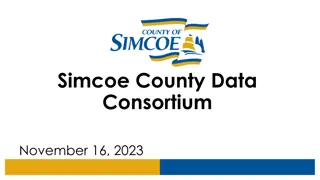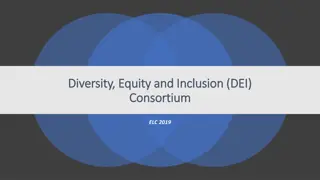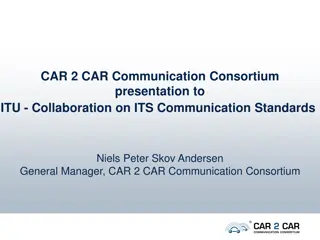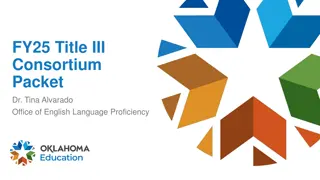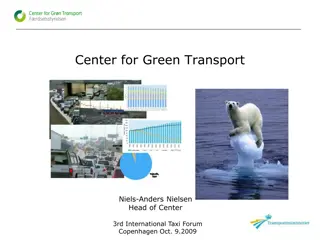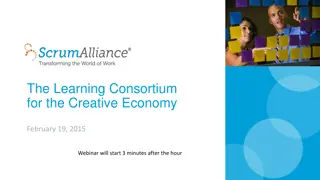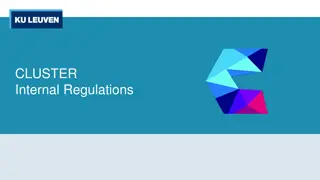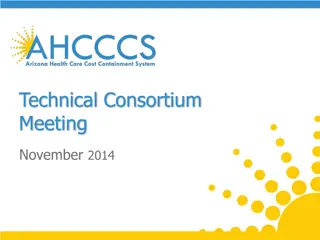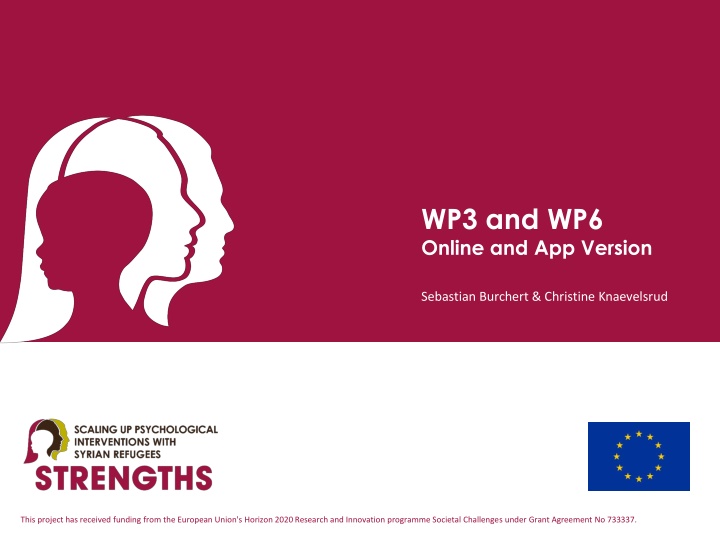
Innovative Online and App Project for Syrian Refugees
This project implements the evidence-based PM+ program for Syrian refugees through online and offline computer and smartphone versions. Activities in WP3 focus on ICT use among refugees, adapting existing interventions, and mHealth frameworks. The project emphasizes managing stress, behavioral activation, social support, and staying well. Features include tailored language options in Levantine Arabic and English, with different narrators guiding users through the intervention.
Download Presentation

Please find below an Image/Link to download the presentation.
The content on the website is provided AS IS for your information and personal use only. It may not be sold, licensed, or shared on other websites without obtaining consent from the author. If you encounter any issues during the download, it is possible that the publisher has removed the file from their server.
You are allowed to download the files provided on this website for personal or commercial use, subject to the condition that they are used lawfully. All files are the property of their respective owners.
The content on the website is provided AS IS for your information and personal use only. It may not be sold, licensed, or shared on other websites without obtaining consent from the author.
E N D
Presentation Transcript
WP3 and WP6 Online and App Version Sebastian Burchert & Christine Knaevelsrud This project has received funding from the European Union's Horizon 2020 Research and Innovation programme Societal Challenges under Grant Agreement No 733337.
Work Package 6 Online Implementation This work package will implement the evidence based PM+ programme by creating an online and offline computer and smartphone based version for Syrian refugees.
Work Package 3 Adaptation Task 3.2 Adaptation of ePM+ The pre-existing WHO concept for electronic PM+ will be further adapted and a culturally adapted contact-on- demand functionality will be developed.
Activities in WP3 Desk-research and consultation o use of information and communications technologies (ICTs) among Syrian refugees: smartphones as main access point o existing WHO online intervention: Step-by-step o need to focus on smartphone adaptation of Step-by-step there will also be a classical online version o identification of mHealth adaptation frameworks
Step-by-step Managing stress Behavioral activation Strengthening social support Staying well Less focus on the steps of Problem Management More activity focused problem solving Positive self-verbalization ( be kind to yourself )
Step-by-step General features This project has received funding from the European Union's Horizon 2020 Research and Innovation programme Societal Challenges under Grant Agreement No 733337.
Arabic and English language versions i Levantine Arabic (spoken) English Language can be chosen in the options section of the app. Levantine Arabic and English versions are the basis for potential future language versions. Texts are written in spoken language, not in formal Arabic.
Chose one of four different narrators i 2 male and 2 female, with a different style of clothing Narrators guide through the intervention They are introduced as previous patients who talk about their own experiences with the program This is intended to provide a certain level of customization. Users can choose a protagonist that is similar to them.
Illustrated narratives i protagonist Dr. character No walls of text. Illustrations that are (to a high degree) culturally neutral and easily adaptable.
Sessions i There are 5 major sessions Sessions are separated into steps All sessions combined take 5 weeks to complete All sessions and steps can be repeated Sessions structure the intervention and leave time to practice new skills.
Slow breathing i Relaxation technique that works with a pre-recorded audio guide. Teaches to focus on breathing and to slow down breathing to reach a relaxed state of body and mind. Managing the physical symptoms of stress and anxiety: Breathing quickens, takes place in the chest and becomes shallower. Results can be: headaches chest pain tiredness dizziness Slow breathing actively counters these effects.
My strength i Create a list of personal strengths / situations in which personal strength was shown. The list can be accessed, changed, sorted and added to at any time. Positive self- verbalization, a simple but effective technique to address negative cognitions.
Small activities i Create a list of small activities that you normally enjoy doing. Examples: Going for a walk Having a cup of tea Relaxation exercise People who are depressed, stressed or who experience grief often become inactive and withdraw from their usual activities. This results in low mood that causes them to withdraw even more. This cycle of inactivity can be broken by becoming active and doing enjoyable activities again. Starting with simple and easy activities can build motivation.
Challenging activities i Creating a list of challenging activities that are likely to improve mood or give a feeling of achievement. Examples: Write about my problems and thoughts Clean the apartment Breaking down a challenging activity into smaller steps. Challenging activities are intended to further break the inactivity cycle. These activities could give pleasure or provide a sense of achievement. To be more manageable and less intimidating, challenging activities can be broken down into smaller steps.
Be kind to yourself i When it is hard to do an activity, the be kind to yourself exercise can be used. Creation of a list of short encouraging messages. Examples: These activities are hard, but they will get easier. I am really helping myself by taking these steps. Positive self- verbalization, a simple but effective technique to address negative cognitions.
Confidence booster i When it is hard to do an activity, it may help to remember something that helps one feeling stronger and more confident. Create a list of confidence boosters. Examples: Picture of a personal good luck charm An addition to the positive self-talk components and a simple technique to deal with difficulties during challenging activities.
Identify obstacles i List of obstacles that might occur when doing activities or the steps of activities. Adding solutions that can be tried when encountering these problems. Examples: Be kind to yourself Confidence booster This introduces problem solving by addressing problems that occur with activities.
Plan activities i Adding activities to the personal planer. Picking activities from a list of activities. For challenging activities, selecting one or more steps (instead of completing the whole activity all at once). Picking a day and a time of day (morning, afternoon or evening). Planer and reminders as means to improve adherence and to ensure that activities are integrated into daily routines. Setting a reminder Notification feature Or personal offline reminders, e.g. a note on the fridge. Marking completed activities.
Plan activities i Planer and reminders as means to improve adherence and to ensure that activities are integrated into daily routines.
Step-by-step Additional features This project has received funding from the European Union's Horizon 2020 Research and Innovation programme Societal Challenges under Grant Agreement No 733337.
e-helpers on-demand i E-helper messaging system Contact-on-demand is integrated in the app Guidance improves adherence. 1. Pick a topic: Content Tech Motivation 2. Send a message 3. Receive an answer by a trained and supervised e-helper (within 24 to 48 hours)
E-helpers Syrians with a refugee background Initial team: Based in Germany Background in Psychology (B.A. Psychology from Syria) Psycho-social helper training
E-helper backoffice Dashboard for e-helpers and coordinators List of new clients List of clients that are assigned to an e-helper Messaging Case notes Administrative tools
Content Management System (CMS) Change content e.g.: correct typo Remove / add content e.g.: add information No programming required
User-centred app development This project has received funding from the European Union's Horizon 2020 Research and Innovation programme Societal Challenges under Grant Agreement No 733337.
Analysis of mHealth literature Four major challenges of mobile mental health with implications for adaptation and implementation: 1. 2. 3. 4. Credibility Availability Usability UX Retention
Credibility Most of the available apps do not provide evidence based content and/or are not tested for efficacy Review: Donker et al. (2013) Review: Nicholas et al. (2015) Review: Huguet et al. (2016)
Availability Most of the evidence based apps are not available Review: Donker et al. (2013) Review: Grist et al. (2017)
Hybrid / Multi-Platform i The app can be downloaded to: iOS Android There will also be a web version (with slightly limited functionality) for use with standard web browsers The intervention should be available for both major operating systems. Users who don t have a smartphone or don t want to download an app can use the web version.
Adaptability / Reusability i Open source code Dissemination requires shareable code that allows the creation of improved or extended versions. Modular programming Can potentially be the basis for other intervention adaptations. Industry standard & future proof tools Well documented code
Retention Apps in general have bad retention rates
Retention mHealth Apps also suffer from this e.g. Roepke et al. (2015) RCT on the depression self-help tool SuperBetter 26.15% of the sample left at post assessment 18.34% left at follow-up assessment
Usability Building an enjoyable app with good graphic design and satisfying interface is necessary for an effective intervention. Bakker et al. (2016) Mental Health Smartphone Apps: Review and Evidence- Based Recommendations for Future Developments
Our tools for adaptation List of evidence-based recommendations for future mHealth developments by Bakker et al. (2016) Two usability evaluation frameworks Brown et al. (2013) & Househ et al. (2015) Kirwan et al. (2012) Two digital intervention development frameworks Mummah et al. (2016) Whittaker et al. (2012)
Our tools for adaptation List of evidence-based recommendations for future mHealth developments by Bakker et al. (2016) We compared the existing Step-by-step version with the set of recommendations. Room for improvement was identified for these aspects: a) (Automated tailoring) b) Reporting of thoughts, feelings and behaviours Mood Tracking c) (Real-time engagement) d) (Activities explicitly linked to specific reported mood problems) e) Gamification Progress indicators (e.g. bars, stars, ) f) Reminders to engage Push notifications g) Simple and intuitive interface and interactions Usability focus
Mood Tracking i User are asked to rate their mood on a regular (e.g. daily or weekly) basis Mood ratings can be added at any time and any number times Mood pattern will be graphically displayed Regular mood tracking has effects on emotional awareness and has been shown to be an effective intervention in itself.
Our tools for adaptation Two usability evaluation frameworks Brown et al. (2013) & Househ et al. (2015) Kirwan et al. (2013) + Health impact Audio and picture as alternative input options for exercises.
Our tools for adaptation Two usability evaluation frameworks Kirwan et al. (2012) Terminology Navigation Interface design Feedback
Audio support i All texts and questionnaires come with on-demand audio-recordings Illiteracy rates among (younger) Syrian refugees are relatively high. Older Syrians might have difficulties reading texts on smaller screens.
Input options i Interactive components of the app require user input There are three different options: Text input Audio recording Taking a picture Illiterate users require alternative ways of using interactive exercises. Different input options improve flexibility.
Offline use i The app can be downloaded to a mobile device Using the app does not require a permanent internet connection However, data transfer requires internet access from time to time Data download and data upload will be kept to a minimum Access to the internet and mobile internet data packages are often limited.
Our tools for adaptation Two digital intervention development frameworks mHealth development is an iterative process Steps of the IDEAS framework (Mummah et al., 2016) Design process phases (Whittaker et al., 2012) WP3 1. 2. 3. 4. 5. 6. Empathize with target users Specify target behaviour Ground in behavioural theory Ideate implementation strategies Create prototypes Gather user feedback on prototypes 1. Conceptualization a. Understanding behaviour b. Identifying intervention options c. Identifying content and implementation options Formative research Pretesting 2. 3. 7. 8. 9. 10. Share widely Build a fully functional pilot version Pilot the intervention Evaluate efficacy 4. 5. 6. 7. Pilot trial Pragmatic randomized controlled trial Qualitative research Scaling-up and implementation evaluation WP6 & WP8
Qualitative assessments on Prototype Health impact (mostly very positive) especially in a country where we live in isolation mostly in winter, when we have our phones all the time in hand, it s nice to have some program like that home, easy going that can help you when you re depressed while nobody else knows about that, this is a positive and interesting thing. (Sweden)
Qualitative assessments on Prototype Terminology (mostly positive) The language is good, as it is very close to the Syrian dialect, as if someone is speaking to you, better understands you and not academic, which is better than the formal Arabic language. (Egypt)
Qualitative assessments on Prototype Interface design (rather controversial) The characters are not attractive, they look very normal and Syrians are very diverse. The girl with hijab doesn t look like Syrian girls, you feel she is an extremist because of the black colour. (Sweden) The illustrations are very good. The pictures are expressive. (both Egypt)
Qualitative assessments on Prototype Performance speed (mostly negative) The program must be faster. I mean there should be more sessions every week, for example, a session every 3 days. (Germany) Memorability The introduction and the messages are too long in a way that the beneficiary might forget the app s objective. (Egypt)
Qualitative assessments on Prototype UX Engagement A nice app, but a little bit boring. (Sweden) The sessions are attractive, as if it`s an adventure. (Egypt) Anyone who sees the app will be curious to try it out. (Egypt)
Next adaptation steps Iterative process We will continue to do user testing in 2018 Room for improvement Shortening sessions: Not in regard to content, but: Having more sessions at shorter intervals Improvements to user interface and navigation Focus on UX and engagement Working with a software development company

